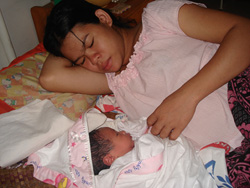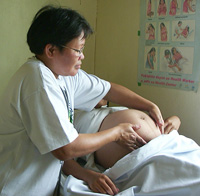News
Philippines: Maternal Mortality Rates Not Making Sufficient Progress to Meet MDGs
- 07 April 2009
News
MANILA - Thousands of Filipino women continue to die due to complications related to childbirth, according to health specialists.
Some 230 women die here for every 100,000 live births, compared with 110 in Thailand, 62 in Malaysia and 14 in Singapore, according to United Nations figures.
Causes of maternal deaths are haemorrhage, sepsis, obstructed labour, hypertensive disorders in pregnancy, and complications of unsafe abortion – most of which are preventable with proper diagnosis and intervention, health specialists said.
“The maternal mortality ratio in the Philippines is listed as the Millennium Development Goal least likely to be achieved by 2015,” Vanessa Tobin, the UNICEF country representative for the Philippines, told IRIN. The country has an adjusted maternal mortality ratio of 160 per 100,000 live births against a goal of 55-60 deaths per 100,000 live births.

“We are not making sufficient progress,” she said.
Based on results of national health surveys, Hendry Plaza, the reproductive health programme officer for UNFPA, the United Nations Population Fund, says: “We will only [achieve] 140 deaths per 100,000 live births in 2015. We are still statistically off-track from the MDG of 55 deaths per 100,000.
“Concerted efforts need to be taken to accelerate and promote cost-effective interventions, such as easy access to emergency obstetric care; increasing the number of births in health facilities; and universal access to reproductive health services, including family planning,” says Plaza.
Crucial to reducing maternal deaths is having a skilled attendant present during a delivery.
“Only 60 percent of the births in the Philippines are supervised by a skilled birth attendant, who can be a physician, a nurse or a midwife with 18 months to two years of adequate training. What is not accepted in this definition is a traditional birth attendant [who have had no formal training],” Tobin said.
“The intermediate goal to reach the MDG is to have a skilled attendant present during every birth. Until that happens, we will not be able to reduce the number of maternal deaths in this country,” she added.
Reproductive health
According to the 2006 Family Planning Survey, only 50.6 per cent of women used family planning methods – unchanged in the past six years.
In the Philippines, more than 80 per cent of the population is Catholic, and only natural family planning methods are sanctioned by the Church.

Condoms, the Pill and other forms of modern contraception are equated with abortion, which is illegal. As a result, contraceptives are not available in most government and rural health clinics.
House Bill 5043, known as the Reproductive Health Bill, advocates a comprehensive range of programmes and services addressing sexual and reproductive health, including education and universal access to both traditional and modern family planning services.
The bill has been languishing in legislative debates for two decades, preventing women, especially in lower income groups, from obtaining reproductive health information and services.
Regional disparities
Specialists say the maternal mortality figures may be scratching the surface as distribution of healthcare among more than 7,000 islands poses a significant challenge.
The wide disparities between urban provinces in Luzon and the underdeveloped provinces in Mindanao are reflected in their regional mortality rates.
Data from the 2003 National Demographic and Health Survey and 2006 Family Planning Survey shows that in the National Capital Region (including Manila), a reported 90 per cent of births are supervised by a skilled birth attendant. In the Autonomous Region of Muslim Mindanao, the comparable figure is 24 per cent.
“In some cases, one midwife is assigned to two to three barangays [small administrative divisions], which are separated by vast bodies of water. So many women opt to go to a community-based traditional birth attendant,” said Fatima Pir Allian, a programme manager for Neighbours Population Development Center, Inc, an NGO that works with UNFPA.
Inaccessibility and lack of personnel are the main factors that contribute to Mindanao having one of the highest MMRs in the country.
Three decades of armed conflict has exacerbated the problem of lack of personnel and accessibility, said Allian.
-- story reported and first published by IRIN